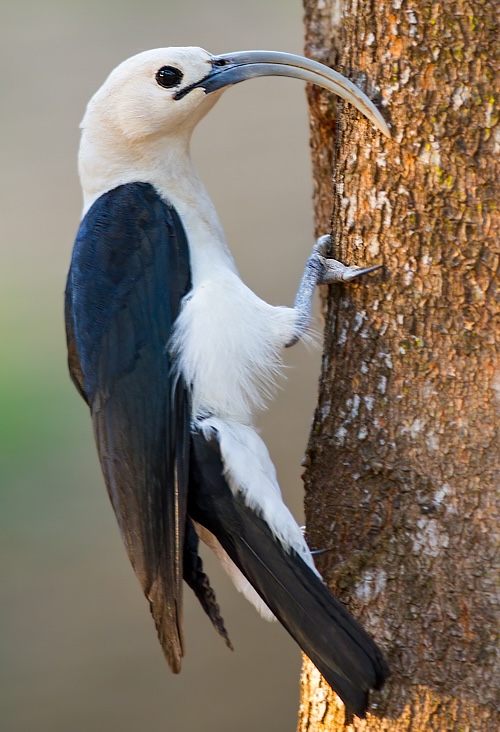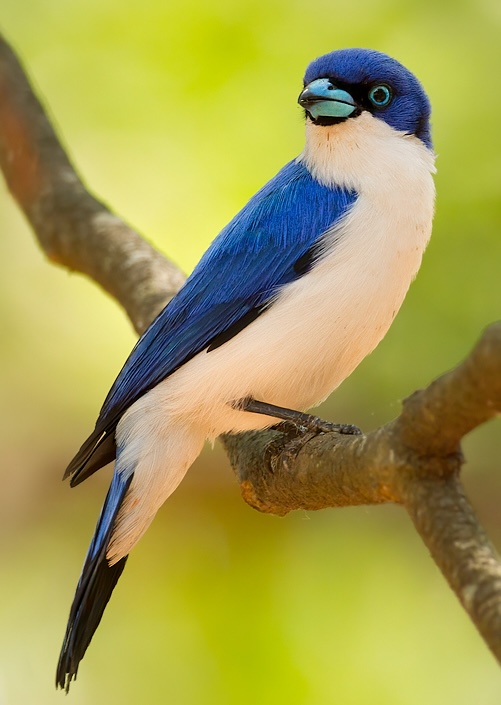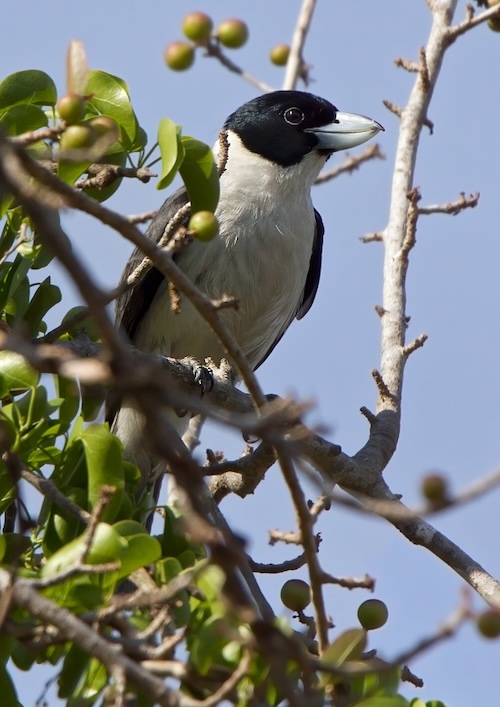Vangidae – Vangas, Woodshrikes & Allies
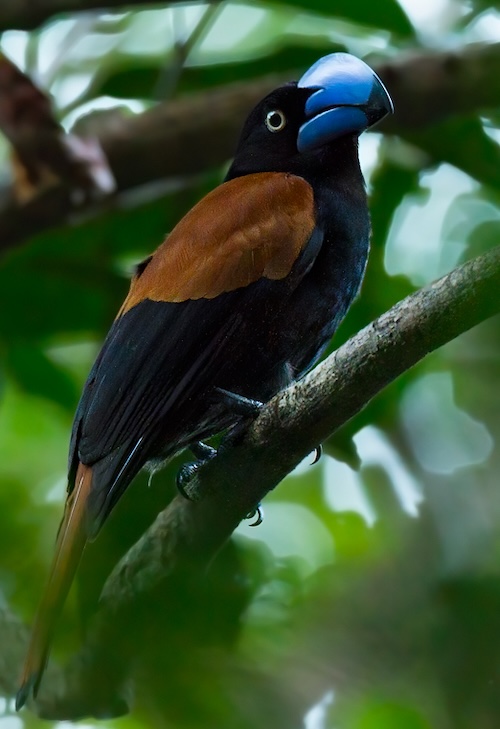
The Vangidae include several groups previously treated as separate families. The vangas are little-known small to medium-sized passerines restricted to Madagascar and the Comoros. There are about 21 species, depending on taxonomy. Most species are shrike-like, arboreal forest birds, feeding on reptiles, frogs and insects. Several other Madagascan birds more similar to Old World warblers, Old World babblers or Old-World flycatchers are now also placed in this family. Vangas differ greatly in bill shape and have a variety of foraging methods. Their stick nests are built in trees. They do not migrate.
The vangas are an example of adaptive radiation, having evolved from a single founding population into a variety of forms adapted to various niches occupied by other bird families in other parts of the world. They differ in size, colour and bill shape but are similar in skull shape and bony palate structure. They are small to medium-sized birds, varying from 12cm to 32cm in length. Many have strong, hooked bills similar to those of shrikes. The Helmet Vanga has a particularly large bill with a casque on top. Other species, such as the newtonia genus, have a small, thin bill. The Sickle-billed Vanga is notable for its long, curved bill used to probe into holes and cracks.
|
|
|
| Sickle-billed Vanga Falculea palliata |
Nuthatch Vanga Hypositta corallirostris |
|
All photos on this page ©Dubi Shapiro |
|
Most vangas are largely black, brown or grey above and white below. Exceptions include the blue and white Blue Vanga and the blue-grey Nuthatch Vanga. The Helmet Vanga is mostly black with a rufous back. Male Bernier’s Vangas are entirely black while the females are brown. It is one of several species with distinct male and female plumage while in other species the sexes are identical. Most vangas have whistling calls.
|
|
|
|
Blue Vanga Cyanolanius madagascarinus |
Bernier’s Vanga Oriolia bernieri |
|
|
|
|
Lafresnaye’s Vanga Xenopirostris xenopirostris |
Chabert Vanga Leptopterus chabert |
All vangas are endemic to Madagascar apart from the Blue Vanga, which also occurs in the Comoros on Mohéli island and, at least formerly, on Grande Comore. They are found throughout Madagascar, in a variety of forest and scrub habitats. Several species including Van Dam’s Vanga and Sickle-billed Vanga can be found in the dry deciduous forests in the west of the island. Some such as Crossley’s Babbler, Helmet Vanga and Bernier’s Vanga are restricted to rainforest in the east of the island. Lafresnaye’s Vanga and the recently discovered Red-shouldered Vanga occur in subarid thorn scrub in the south-west. 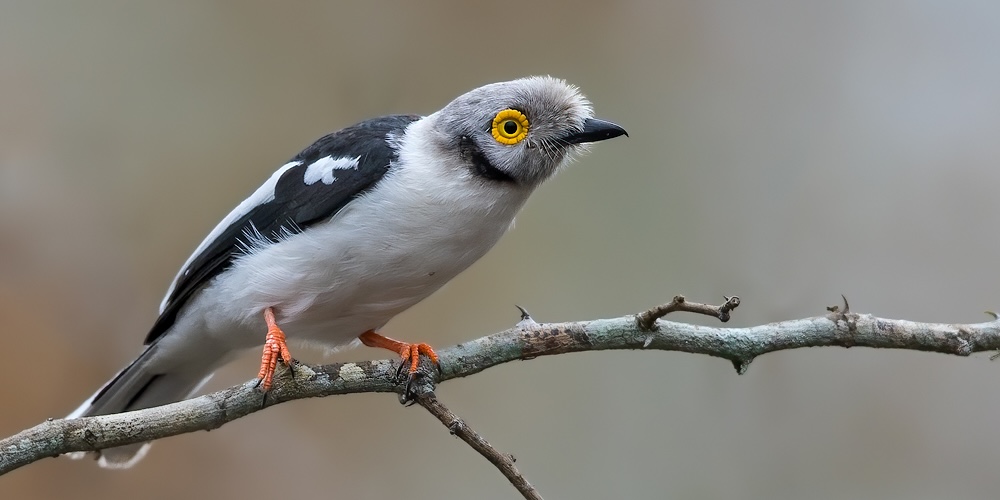
White-crested Helmetshrike Prionops plumatus

Gabela Helmetshrike Prionops gabela
Their diet can include insects, earthworms, millipedes, lizards and amphibians. The Blue Vanga and Chabert Vanga occasionally eat fruit. Many species feed in small groups, often in mixed-species foraging flocks. The Hook-billed Vanga and Lafresnaye’s Vanga tend to forage alone. Vangas have a variety of different foraging strategies. Many species glean food as they move through the branches. The nuthatch Vanga climbs up trunks and branches like a nuthatch but does not climb downwards as nuthatches do. Crossley’s Babbler forages by walking along the forest floor amongst the leaf litter. The Chabert Vanga and the Tylas Vanga often fly into the air to catch prey. The three Xenopirostris vangas use their laterally flattened bills to strip bark off trees to search for food underneath.
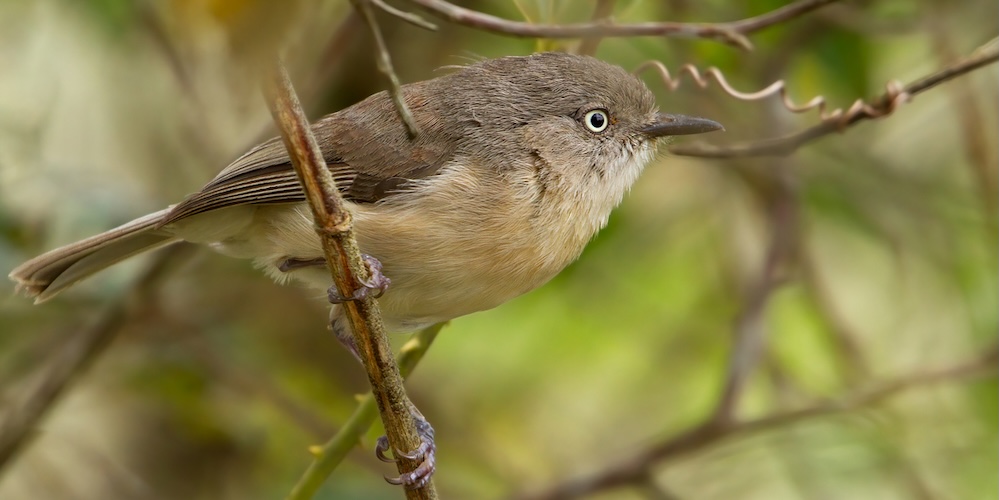
Common Newtonia Newtonia brunneicauda
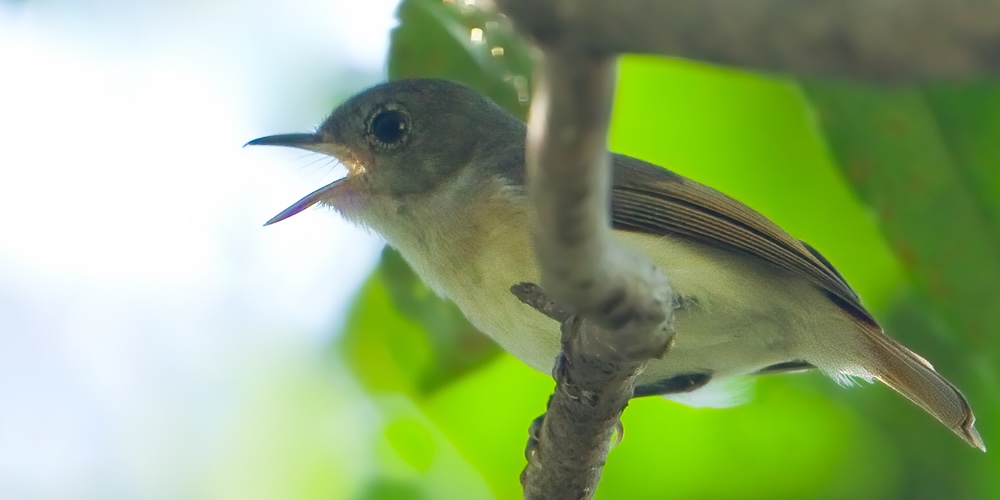
Red-tailed Newtonia Newtonia fanovanae
Most species nest in pairs, building cup-shaped nests using twigs, bark, roots and leaves. The Sickle-billed Vanga nests in groups and builds a large nest of sticks. Following DNA sequencing there are now thought to be forty species in the family Vangidae.
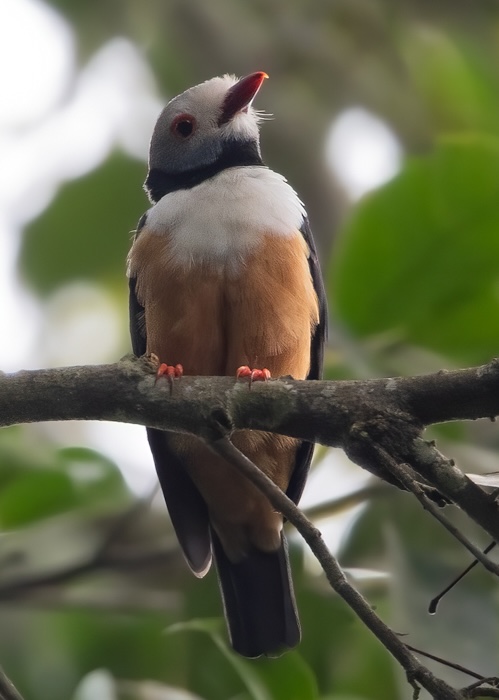 |
|
|
Rufous-bellied Helmetshrike Prionops rufiventris |
Ward’s Flycatcher Pseudobias wardi |
The Prionopidae were treated as a separate family of mid-sized passerine species. Previous to that, the helmetshrikes, were included with the true shrikes in the family Laniidae, and later on split between several presumably closely related groups such as Malaconotidae (Bushshrikes) and Campephagidae (Cuckooshrikes), but are now considered sufficiently close to Vangas to be included in the Vangidae family.
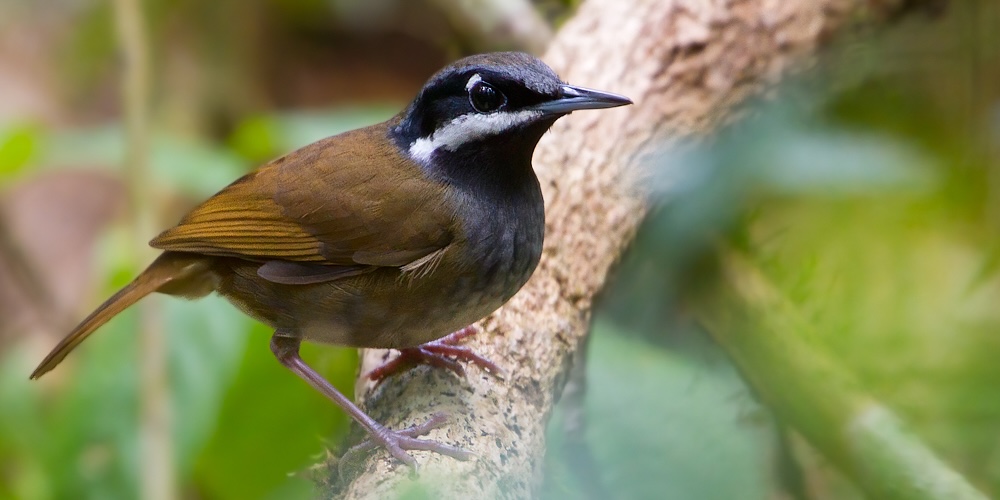
Crossley’s Vanga Mystacornis crossleyi
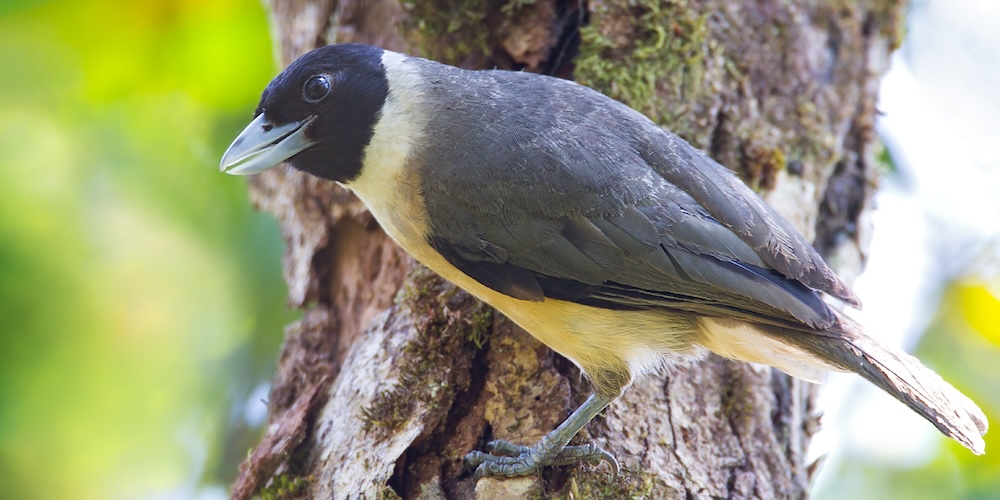
Pollen’s Vanga Xenopirostris polleni
This is an African group of species which are found in scrub or open woodland. They are similar in feeding habits to shrikes, hunting insects and other small prey from a perch on a bush or tree. Although similar in build to the shrikes, these tend to be colourful species with the distinctive crests or other head ornaments, such as wattles, from which they get their name. They are noisy and sociable birds, some of which breed in loose colonies. They lay 2-4 eggs in neat, well-hidden nests.
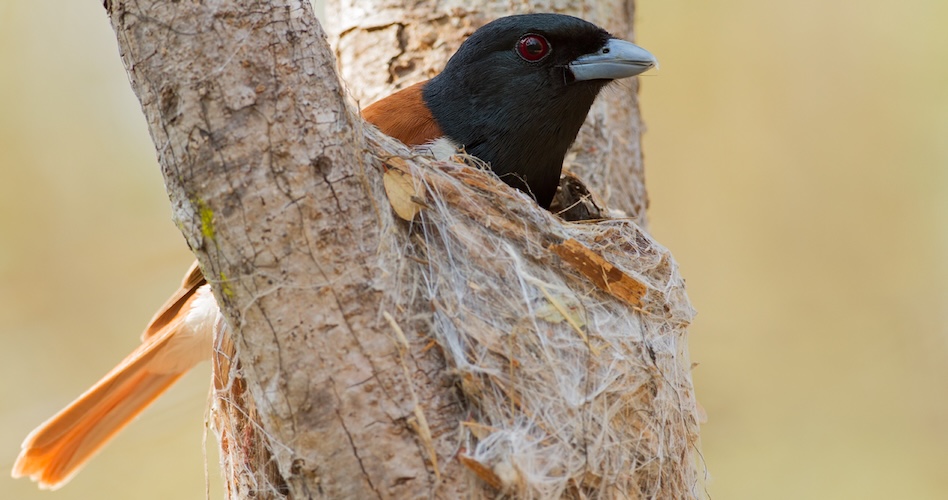
Rufous Vanga Schetba rufa

Red-shouldered Vanga Calicalicus rufocarpalis
The Woodshrikes and allies were previously considered to be a separate passerine family – the Tephrodornithidae covering the genera Hemipus, Tephrodornis and Philentoma. The family was proposed (2006) on the basis of a molecular phylogenetic study by Moyle which showed a close relation between Hemipus and Tephrodornis. However, more recently some taxonomists argued for a broader treatment of the genera under the Vangidae, which is now accepted.
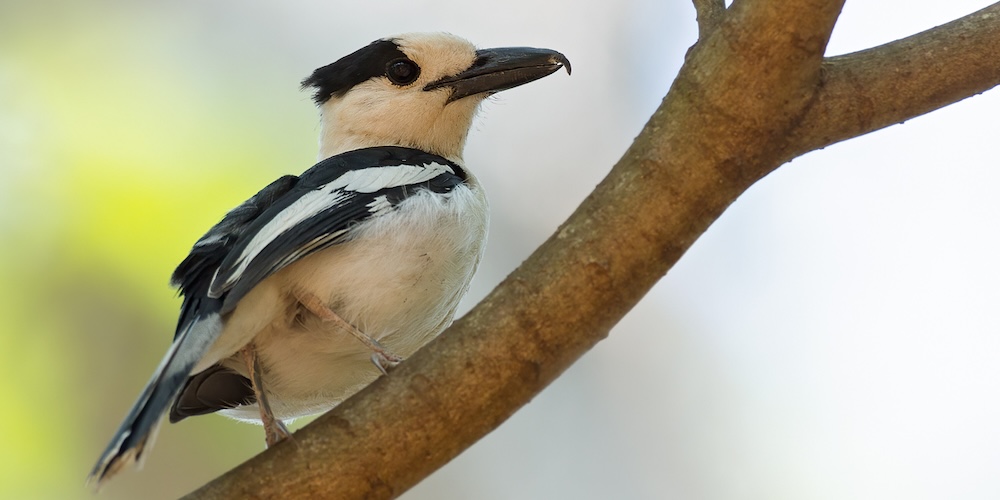
Hook-billed Vanga Vanga curvirostris
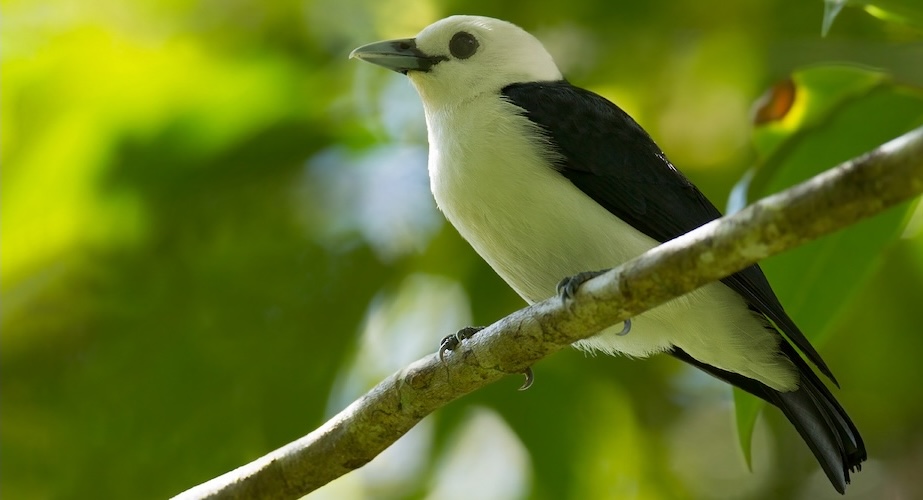
White-headed Vanga Artamella viridis
-
Number of bird species: 40
(As at October 2025)
According to the recently (2025) amalgamated AviList, there are forty species in the Vangidae family in twenty-one genera. They are:
Maroon-breasted Philentoma Philentoma velata
Rufous-winged Philentoma Philentoma pyrhopterum
White-crested Helmetshrike Prionops plumatus
Grey-crested Helmetshrike Prionops poliolophus
Yellow-crested Helmetshrike Prionops alberti
Red-billed Helmetshrike Prionops caniceps
Rufous-bellied Helmetshrike Prionops rufiventris
Retz’s Helmetshrike Prionops retzii
Gabela Helmetshrike Prionops gabela
Chestnut-fronted Helmetshrike Prionops scopifrons
African Shrike-flycatcher Megabyas flammulatus
Black-and-white Shrike-flycatcher Bias musicus
Black-winged Flycatcher-shrike Hemipus hirundinaceus
Bar-winged Flycatcher-shrike Hemipus picatus
Malabar Woodshrike Tephrodornis sylvicola
Large Woodshrike Tephrodornis virgatus
Common Woodshrike Tephrodornis pondicerianus
Sri Lanka Woodshrike Tephrodornis affinus
Tylas Vanga Tylas eduardi
Red-tailed Vanga Calicalicus madagascariensis
Red-shouldered Vanga Calicalicus rufocarpalis
Archbold’s Newtonia Newtonia archboldi
Common Newtonia Newtonia brunneicauda
Dark Newtonia Newtonia amphichroa
Red-tailed Newtonia Newtonia fanovanae
Nuthatch Vanga Hypositta corallirostris
Chabert Vanga Leptopterus chabert
Crossley’s Babbler Mystacornis crossleyi
Blue Vanga Cyanolanius madagascarinus
Comoro Blue Vanga Cyanolanius comorensis
Hook-billed Vanga Vanga curvirostris
Ward’s Flycatcher Pseudobias wardi
Helmet Vanga Euryceros prevostii
Rufous Vanga Schetba rufa
Pollen’s Vanga Xenopirostris polleni
Lafresnaye’s Vanga Xenopirostris xenopirostris
Van Dam’s Vanga Xenopirostris damii
Bernier’s Vanga Oriolia bernieri
Sickle-billed Vanga Falculea palliata
White-headed Vanga Artamella viridis
-
Vangidae
Family AccountFollowing a storyline repeated on many isolated island environments, a passerine immigrant to Madagascar millions of years ago gave rise to descendants with a bewildering array of bill types perfectly suited to the types of vegetation that evolved around them. -
Vangidae
Family AccountThe family Vangidae comprises a group of often shrike-like medium-sized birds distributed from Asia to Africa, including the vangas of Madagascar to which...
Although this is a medium sized family with forty species in twenty-one genera, Fatbirder provides active links below to all species.
-
African Shrike-flycatcher Megabyas flammulatus
Species AccountA distinctive shrike-like bird of forest and forest edge, often seen perched upright on branches wagging its tail from side to side. -
African Shrike-flycatcher Megabyas flammulatus
Species AccountSound archive and distribution map. -
Archbold’s Newtonia Newtonia archboldi
Species AccountArchbold's newtonia (Newtonia archboldi) is a species of bird in the family Vangidae. It is endemic to Madagascar. -
Archbold’s Newtonia Newtonia archboldi
Species AccountSound archive and distribution map. -
Bar-winged Flycatcher-shrike Hemipus picatus
Species Accountd with a declining or fluctuating range size, habitat extent/quality, or population size and a small number of locations or severe fragmentation). Despite the fact that the population trend appears to be decreasing, the decline is not believed to be sufficiently rapid to approach the threshold for Vulnerable under the population trend criterion (>30% decline over ten years of three generations) -
Bar-winged Flycatcher-shrike Hemipus picatus
Species AccountThe bar-winged flycatcher-shrike (Hemipus picatus) is a small passerine bird formerly placed in the cuckooshrike family but probably closer to the woodshrikes. It is found in the forests of tropical southern Asia from the Himalayas and hills of the Indian subcontinent east to Indonesia. -
Bar-winged Flycatcher-shrike Hemipus picatus
Species AccountSound archive and distribution map. -
Bernier’s Vanga Oriolia bernieri
Species AccountLarge, slim, dark, long-billed vanga. Males are glossy black, females are rich brown with dark bars, and both sexes show a piercing pale eye. -
Bernier’s Vanga Oriolia bernieri
Species AccountSound archive and distribution map. -
Black-and-white Shrike-flycatcher Bias musicus
Species AccountUnusual, chunky, short-tailed, crested, yellow-eyed member of the vanga family. -
Black-and-white Shrike-flycatcher Bias musicus
Species AccountSound archive and distribution map. -
Black-winged Flycatcher-shrike Hemipus hirundinaceus
Species AccountSound archive and distribution map. -
Black-winged Flycatcher-shrike Hemipus hirundinaceus
Species AccountThe black-winged flycatcher-shrike (Hemipus hirundinaceus) is a species of bird in the flycatcher-shrike genus, Hemipus. It is traditionally included in the cuckooshrike family, but most taxonomists place it with the woodshrikes. -
Blue Vanga Cyanolanius madagascarinus
Species AccountThe blue vanga (Cyanolanius madagascarinus) is a bird species in the family Vangidae. -
Blue Vanga Cyanolanius madagascarinus
Species AccountSound archive and distribution map. -
Chabert's Vanga Leptopterus chabert
Species AccountThe chabert vanga (Leptopterus chabert), also erroneously called "Chabert's vanga", is a species of bird in the family Vangidae. It is monotypic within the genus Leptopterus. -
Chabert's Vanga Leptopterus chabert
Species AccountThe spiny forest of southwestern Madagascar is one of the world's strangest habitats, dominated by tall, spiky Alluaudia procera trees. -
Chabert's Vanga Leptopterus chabert
Species AccountLeptopterus chabert is listed as Least Concern. -
Chabert's Vanga Leptopterus chabert
Species AccountSound archive and distribution map. -
Chestnut-fronted Helmetshrike Prionops scopifrons
Species AccountThe chestnut-fronted helmetshrike (Prionops scopifrons) is a species of bird in the Vanga family Vangidae, formerly usually included in the Malaconotidae. -
Chestnut-fronted Helmetshrike Prionops scopifrons
Species AccountThe chestnut-fronted helmetshrike (Prionops scopifrons) is a species of bird in the helmetshrike family Prionopidae, formerly usually included in the Malaconotidae. -
Chestnut-fronted Helmetshrike Prionops scopifrons
Species AccountSound archive and distribution map. -
Chestnut-fronted Helmetshrike Prionops scopifrons
Species AccountSound archive and distribution map. -
Common Newtonia Newtonia brunneicauda
Species AccountEnergetic and pugnacious little plain-brown vanga. The eye is white, and the center of the chest usually orange. -
Common Newtonia Newtonia brunneicauda
Species AccountSound archive and distribution map. -
Common Woodshrike Tephrodornis pondicerianus
Species AccountThe common woodshrike (Tephrodornis pondicerianus) is a species of bird found in Asia. It has been placed in the cuckoshrike (Campephagidae) and helmetshrike (Prionopidae) families in the past and is now considered a member of the family Tephrodornithidae. It is small and ashy brown with a dark cheek patch and a broad white brow. It is found across Asia mainly in the thin forest and scrub habitats. The form found in Sri Lanka which was treated as a subspecies is now usually considered a separate species, the Sri Lanka woodshrike. -
Common Woodshrike Tephrodornis pondicerianus
Species AccountSound archive and distribution map. -
Comoro Blue Vanga Cyanolanius comorensis
Species AccountThe Comoros blue vanga or Comoro blue vanga (Cyanolanius comorensis) is a bird species in the family Vangidae. -
Comoro Blue Vanga Cyanolanius comorensis
Species AccountSound archive and distribution map. -
Crossley’s Vanga Mystacornis crossleyi
Species AccountBrown-backed, babbler-like vanga of the forest understory. Male has a black hood, and female a white throat. Endemic to Madagascar, in eastern rainforest. -
Crossley’s Vanga Mystacornis crossleyi
Species AccountCrossley's vanga (Mystacornis crossleyi), also known as Crossley's babbler-vanga, Crossley's babbler, Madagascar groundhunter, or Madagascar groundjumper... -
Crossley’s Vanga Mystacornis crossleyi
Species AccountSound archive and distribution map. -
Dark Newtonia Newtonia amphichroa
Species AccountEnergetic and pugnacious little dark-brown vanga. The eye is brown, and the underparts are grayish. Madagascar endemic that is found in eastern rainforest. -
Dark Newtonia Newtonia amphichroa
Species AccountSound archive and distribution map. -
Gabela Helmetshrike Prionops gabela
Species AccountThe Gabela helmetshrike (Prionops gabela) is a species of bird in the helmetshrike family Prionopidae, formerly usually included in the Malaconotidae. -
Gabela Helmetshrike Prionops gabela
Species AccountSound archive and distribution map. -
Gabela Helmetshrike Prionops gabela
Species AccountThe Gabela helmetshrike (Prionops gabela) is a species of bird in the Vanga family Vangidae, formerly usually included in the Malaconotidae. -
Gabela Helmetshrike Prionops gabela
Species AccountSound archive and distribution map. -
Grey-crested Helmetshrike Prionops poliolophus
Species AccountThe grey-crested helmetshrike (Prionops poliolophus) is a species of bird in the helmetshrike family Prionopidae, formerly usually included in the Malaconotidae. -
Grey-crested Helmetshrike Prionops poliolophus
Species AccountSound archive and distribution map. -
Helmet Vanga Euryceros prevostii
Species AccountHuge black vanga with a rufous back and an enormous blue bill. Rare and localized Madagascar endemic that is found in northeastern rainforest at low and middle... -
Helmet Vanga Euryceros prevostii
Species AccountSound archive and distribution map. -
Hook-billed Vanga Vanga curvirostris
Species AccountHook-billed Vanga Vanga curvirostris Madagascar endemic that uses all types of forest, and some plantations and scrub. -
Hook-billed Vanga Vanga curvirostris
Species AccountSound archive and distribution map. -
Lafresnaye’s Vanga Xenopirostris xenopirostris
Species AccountLafresnaye's vanga (Xenopirostris xenopirostris) is a species of bird in the vanga family Vangidae. -
Lafresnaye’s Vanga Xenopirostris xenopirostris
Species AccountSound archive and distribution map. -
Large Woodshrike Tephrodornis virgatus
Species AccountThe large woodshrike (Tephrodornis gularis, the name T. virgatus provided as a substitute on insufficient grounds.[2]) is a species in the woodshrike family Tephrodornithidae. The woodshrikes were formerly placed in the Campephagidae (cuckooshrikes) sometimes. -
Large Woodshrike Tephrodornis virgatus
Species AccountSound archive and distribution map. -
Malabar Woodshrike Tephrodornis sylvicola
Species AccountThe Malabar woodshrike (Tephrodornis sylvicola) is a species of bird in the woodshrike family Tephrodornithidae. It is found in western India. It is sometimes considered a subspecies of the large woodshrike. -
Malabar Woodshrike Tephrodornis sylvicola
Species AccountTephrodornis sylvicola is listed as Least Concern. -
Malabar Woodshrike Tephrodornis sylvicola
Species AccountSound archive and distribution map. -
Maroon-breasted Philentoma Philentoma velatum
Species AccountThe maroon-breasted philentoma (Philentoma velata) is a bird species. Long placed in the flycatcher family (Muscicapidae) when these were used as a "wastebin taxon", they are now tentatively assigned to the Tephrodornithidae pending detailed study. It is found in Brunei, Indonesia, Malaysia, Myanmar, Singapore, and Thailand. Its natural habitats are subtropical or tropical moist lowland forests and subtropical or tropical swamps. It is threatened by habitat loss. -
Maroon-breasted Philentoma Philentoma velatum
Species AccountSound archive and distribution map. -
Nuthatch Vanga Hypositta corallirostris
Species AccountSmall blue vanga that acts like a creeper or small woodpecker, feeding by climbing up tree trunks. Male is all blue, while female is greenish-blue... -
Nuthatch Vanga Hypositta corallirostris
Species AccountSound archive and distribution map. -
Pollen’s Vanga Xenopirostris polleni
Species AccountPollen's vanga (Xenopirostris polleni) is a species of bird in the family Vangidae. -
Pollen’s Vanga Xenopirostris polleni
Species AccountSound archive and distribution map. -
Red-billed Helmetshrike Prionops caniceps
Species AccountSound archive and distribution map. -
Red-billed Helmetshrike Prionops caniceps
Species AccountThe red-billed helmetshrike or chestnut-bellied helmetshrike (Prionops caniceps) is a species of bird in the helmetshrike family Prionopidae, formerly usually included in the Malaconotidae. -
Red-shouldered Vanga Calicalicus rufocarpalis
Species AccountThe red-shouldered vanga (Calicalicus rufocarpalis) is a member of the vanga family endemic to south-west Madagascar. -
Red-shouldered Vanga Calicalicus rufocarpalis
Species AccountSound archive and distribution map. -
Red-tailed Newtonia Newtonia fanovanae
Species AccountThe red-tailed newtonia (Newtonia fanovanae) is a species of bird in the family Vangidae. It is endemic to Madagascar. -
Red-tailed Newtonia Newtonia fanovanae
Species AccountSound archive and distribution map. -
Red-tailed Vanga Calicalicus madagascariensis
Species AccountIt is endemic to Madagascar. Its natural habitats are subtropical or tropical dry forests and subtropical or tropical moist lowland forests. -
Red-tailed Vanga Calicalicus madagascariensis
Species AccountSound archive and distribution map. -
Retz's Helmetshrike Prionops retzii
Species AccountThe Retz's helmetshrike (Prionops retzii) is a species of bird in the helmetshrike family Prionopidae, formerly usually included in the Malaconotidae. -
Retz's Helmetshrike Prionops retzii
Species AccountSound archive and distribution map. -
Roufous Vanga Schetba rufa
Species AccountThe rufous vanga (Schetba rufa) is a species of bird in the Vangidae family. It is monotypic within the genus Schetba. -
Roufous Vanga Schetba rufa
Species AccountSound archive and distribution map. -
Rufous-bellied Helmetshrike Prionops rufiventris
Species AccountSound archive and distribution map. -
Rufous-bellied Helmetshrike Prionops rufiventris
Species AccountThe rufous-bellied helmetshrike or Gabon helmetshrike (Prionops rufiventris) is a passerine bird belonging to the helmetshrike family, Prionopidae. It inhabits tropical forest in Central Africa. It is sometimes included within the chestnut-bellied helmetshrike (P. caniceps) of West Africa. -
Rufous-winged Philentoma Philentoma pyrhopterum
Species AccountThe rufous-winged philentoma (Philentoma pyrhoptera) is a bird species. Long placed in the flycatcher family (Muscicapidae) when these were used as a "wastebin taxon", they are now tentatively assigned to the Tephrodornithidae pending detailed study. It is found in Brunei, Indonesia, Malaysia, Myanmar, Thailand, and Vietnam. Its natural habitat is subtropical or tropical moist lowland forests. -
Rufous-winged Philentoma Philentoma pyrhopterum
Species AccountSound archive and distribution map. -
Sickle-billed Vanga Falculea palliata
Species AccountThe sickle-billed vanga (Falculea palliata) is a species of bird in the vanga family Vangidae. It is monotypic within the genus Falculea. It is endemic to Madagascar. Its natural habitats are tropical dry forests and tropical dry shrubland. -
Sickle-billed Vanga Falculea palliata
Species AccountSound archive and distribution map. -
Sickle-billed Vanga Falculea palliata
Species AccountHuge black-and-white vanga with a long curved bill. Juveniles have shorter bills. Madagascar endemic that is found at low elevations in spiny forest. -
Sickle-billed Vanga Falculea palliata
Species AccountSound archive and distribution map. -
Sri Lanka Woodshrike Tephrodornis affinus
Species AccountSound archive and distribution map. -
Sri Lanka Woodshrike Tephrodornis affinus
Species AccountThe Sri Lanka woodshrike (Tephrodornis affinis ) is a species of bird in the woodshrike family Tephrodornithidae. It is found on Sri Lanka. It is sometimes considered a subspecies of the common woodshrike. -
Tylas Vanga Tylas eduardi
Species AccountMedium-sized vanga with a white collar, a black head, and normally rufous underparts. Madagascar endemic that is primarily found in the eastern rainforest. -
Tylas Vanga Tylas eduardi
Species AccountSound archive and distribution map. -
Van Dam’s Vanga Xenopirostris damii
Species AccountVan Dam's vanga (Xenopirostris damii) is a species of bird in the family Vangidae. It is endemic to Madagascar. -
Van Dam’s Vanga Xenopirostris damii
Species AccountSound archive and distribution map. -
Ward’s Flycatcher Pseudobias wardi
Species AccountSmall black-and-white vanga that looks uncannily like a monarch flycatcher. -
Ward’s Flycatcher Pseudobias wardi
Species AccountSound archive and distribution map. -
White-crested Helmetshrike Prionops plumatus
Species AccountThe white-crested helmetshrike (Prionops plumatus), also known as the white helmetshrike, is a species of passerine bird in the helmetshrike family Prionopidae, formerly usually included in the Malaconotidae. -
White-crested Helmetshrike Prionops plumatus
Species AccountSound archive and distribution map. -
White-headed Vanga Artamella viridis
Species AccountMid-sized black-backed vanga with a typical bill. -
White-headed Vanga Artamella viridis
Species AccountSound archive and distribution map. -
Yellow-crested Helmetshrike Prionops alberti
Species AccountThe yellow-crested helmetshrike (Prionops alberti) is a species of bird in the helmetshrike family Prionopidae, formerly usually included in the Malaconotidae. -
Yellow-crested Helmetshrike Prionops alberti
Species AccountSound archive and distribution map. -
Yellow-crested Helmetshrike Prionops alberti
Species AccountA distinctive black helmetshrike with a bright yellow crown and crest, orange eye-rings, and pink legs and feet. A rare and threatened species. -
Yellow-crested Helmetshrike Prionops alberti
Species AccountSound archive and distribution map.

